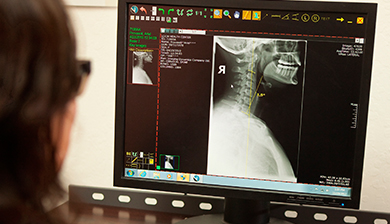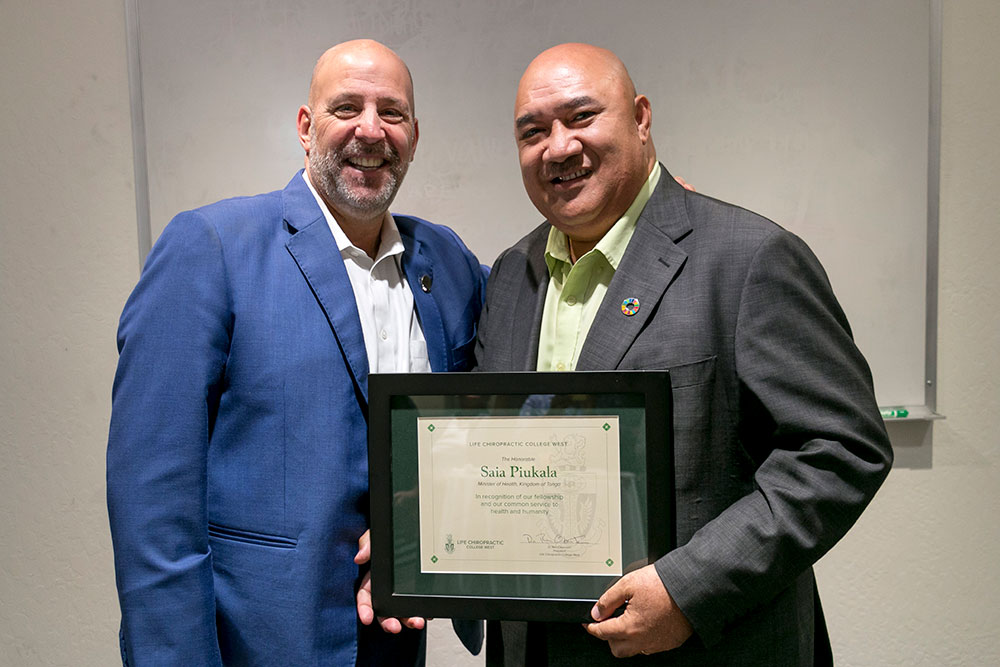– Dr. Joe Betz, Dr. Deed Harrison, Dr. Paul Oakley –
Three researchers have been at the forefront of the debate on whether spine radiography has clinical utility in chiropractic technique and practice. Over the years Dr. Deed Harrison, Dr. Joe Betz and Dr. Paul Oakley have written critical analyses, literature reviews and studies that rebut the position that X-ray use in chiropractic is unnecessary or even dangerous. The debate has recently re-ignited after a 2020 paper published in the journal Chiropractic and Manual Therapies titled The clinical utility of routine spinal radiographs by chiropractors: a rapid review of the literature, by Melissa Corso, Carol Cancelliere, Pierre Côté.
Dr. Harrison is a Life West graduate (‘96), president of Chiropractic Biophysics and prolific researcher. Dr. Betz graduated from Life University (‘01) and heads the research committee for the ICA. Dr. Oakley is a Palmer College graduate (‘03) and a PhD candidate in Kinesiology and Health Sciences at York University. Together they have provided perspective and analysis on this issue that is benefiting the profession as a whole, ensuring that all sides of the debate are covered and the outcomes are solidly based on the entire spectrum of published research and facts.
In the mid 1990s the debate began in the scientific literature with Dr. Don Harrison (Dr. Deed’s father) on one side and researchers including Dr. Mitch Haas from Western States Chiropractic College and Dr. John Taylor from New York Chiropractic College on the other. These past exchanges in journals and at scientific conferences culminated in 2005 with the publication of the Council on Chiropractic Guidelines and Practice Parameters (CCGPP) series of “Guidelines” (now re-branded as the Clinical Compass). Although the profession largely refuted the validity of these guidelines, they ultimately were used by many in the insurance managed care industry. The diagnostic imaging guidelines adopted by the CCGPP/Clinical Compass were prepared by Dr. André Bussières, professor at McGill University and Trois-Rivières University college of chiropractic. They included no studies on subluxation assessment and technique nor patient outcomes regarding X-ray. Volumes of studies were ultimately ignored or excluded in their analysis of the literature. Drs. Don and Deed Harrison, Betz and Oakley responded by beginning work on a counter-guideline that looked at everything that the CCGPP red flag guidelines were not willing to look at. This project took several years and was finally published in 2009 as the Practicing Chiropractor’s Committee on Radiology Protocols (PCCRP Guidelines). Endorsed by many national and international chiropractic bodies, this document was also accepted for inclusion in the National Guideline
Clearinghouse and included around 1200 research citations.
While the guideline debate was raging, the attacks in the peer-reviewed literature continued with Drs. Sanne Toftgaard Christensen and Jan Hartvigsen publishing a systematic literature review with the goal of determining whether sagittal spinal curves are associated with health in epidemiological studies. This study was published in the Journal of Manipulative & Physiological Therapeutics in 2008. This review found that the entire sagittal plane of the spine is irrelevant and meaningless to patient outcomes. Again, Drs. Harrison, Betz and Oakley teamed up to write the rebuttal al. JMPT would not accept the formal critiques and the team ended up writing a major review of the Christensen and Hartvigsen paper that was published in the Annals of Vertebral Subluxation Research, Volume 2009. They found that the authors had overlooked the majority of the studies specific to their research question including seventy-four studies that were left out of their literature review. Analysis of the data provided by the authors in these missed studies combined with the studies cited in the literature review showed that 78% of the total studies found a positive association between sagittal plane curves/posture and health disorders. Drs. Harrison, Betz and Oakley remain perplexed how Drs. Christensen and Hartvigsen could have missed nearly all of the studies showing a positive correlation between sagittal spine alignment and various health parameters, including pain.
When asked by Dr. Ron Oberstein, President of Life West, in his Leadership Lines series of webcasts, why the gap is so wide in the research, Dr. Oakley pointed out that many of the PhD/DC researchers and writers use a very academic lens and seldom if ever have been in practice. Their grasp of the practice of chiropractic was limited by this and it showed in the research outcomes. In the same interview Dr. Betz stated he felt that these researchers were trying to do what is best for the profession, but the outcomes were contrary to what has been seen in practice for over 100
years. They were trying to pigeon-hole chiropractic into a more pain-centric model of care and did not focus on the impact the spine had on overall health. Dr. Harrison commented that an agenda to make X-ray look unscientific is a flawed process and very bad for the profession.
More recently, the X-ray issue took off again in 2018 with the publication in the journal Chiropractic and Manual Therapies of the article titled Current Evidence for Spinal X-ray Use in the Chiropractic Profession. Written largely by researchers from Macquarie University in Sydney Australia, the article generated heated debate at the World Federation of Chiropractic 2018 Conference in Berlin, which resulted in the ACA adopting their often critical and controversial Choosing Wisely statement. As Dr. Harrison stated in the webcast: “then we all know what red flag X-ray is – don’t X-ray patients regularly in your practice, don’t use X-rays for safety, don’t use X-rays to change the spine, don’t ever take post X-rays.” In October 2019 Drs. Harrison and Oakley responded to the Macquarie article in the Annals of Vertebral Subluxation Research with their article titled Selective Usage of Medical Practice Data Misrepresentations and Omission of Conflicting Data to Support the ‘red flag only’ Agenda for Chiropractic Radiography Guidelines.
And then in 2020 the most recent episode of this debate landed with the publication of the article by Melissa Corso, Carol Cancelliere, Pierre Côté noted above. This was termed a “rapid review of the literature” and was commissioned by the College of Chiropractors of Briti sh Columbia (CCBC). In February 2021, the CCBC approved amendments to the Professional Conduct Handbook (PCH) Part 2, Part 15 and Appendix L regarding diagnostic imaging in the practice of chiropractic. The changes allow the use of X-ray “only if the application of X-rays is indicated by a patient history or physical examination that identifies serious pathology or clinical reasons to suspect serious pathology.” In addition, the rules now state: “routine or repeat X-rays used as a regular protocol during the evaluation and diagnosis of patients are not clinically justified.”
It is extremely important to note that the rapid review by Dr. Côté failed to include any research papers published since 2005 and ultimately included only nine articles in their analysis. And once again, the journal that published this research article (Chiropractic and Manual Therapies) refused to publish any letters to the editor from several sources criticizing the methodology and findings of the study. The critical analysis of this research article had to be sent to an outside journal. The critique article was finally published in the journal Dose Response in November 2021 by the ICA Rapid Response Research Review Subcommittee with the title Smoke Screen to Distract From Flawed Science: A Response to Côté et. Over Criticisms to Their Deficient ‘Rapid Review’ on Chiropractic X-Ray Utility. The authors showed dozens of chiropractic studies that were missed according to the Corso article’s own strict inclusion/exclusion criteria, as well as over 100 others that showed definitive clinical utility of X-ray use in the screening, assessment, diagnosis,and follow-up of patients seen in routine chiropractic practice.
It is likely this debate will continue on as provincial and state governments take one side or another as has happened in British Columbia. Critical for these decisions is to ensure the academic and scientific integrity of the research that is being produced. Dr. Harrison, as head of Chiropractic Biophysics and a clinician, sees the largely academic approach of the anti X-ray lobby as unfortunate: “The Côté study did not look at the thirteen randomized trials that my (Biophysics) group has done that clearly document that X-ray utilization and X-ray based care actually improves patient outcomes across the board.” In the same webcast Dr. Oakley observed that “the big elephant in the room is that X-ray exposure is no longer the cause of cancer it once was attributed to, and in the Côté responses to our letters to the editors of the journal, not once was there any mention of radiation exposure. The arguments were purely academic.” He continued: “The whole rationale of rapid literature review, inappropriate referencing with the WHO guidelines, eliminating valid studies not performed by chiropractors, missed and excluded reliability studies and clinical outcome studies, failure to include upper cervical, full spine, pelvis and leg length equality papers, failure to include studies on anomalies and pathologies that would alter manipulative treatment, failure to define red flags and eliminating valid studies based on bias, and very strong conclusions based on little and conflicting evidence, this all points to anti-imaging bias.”
Of one thing we can be certain: this debate has not ended. As Dr. Oberstein thanked Drs. Deed Harrison, Joe Betz and Paul Oakley for their contributions, he concluded that what was at stake was academic integrity in research and the highest ethics in chiropractic research, to enable the profession to come together around the many techniques that utilize imaging for better patient outcomes.








